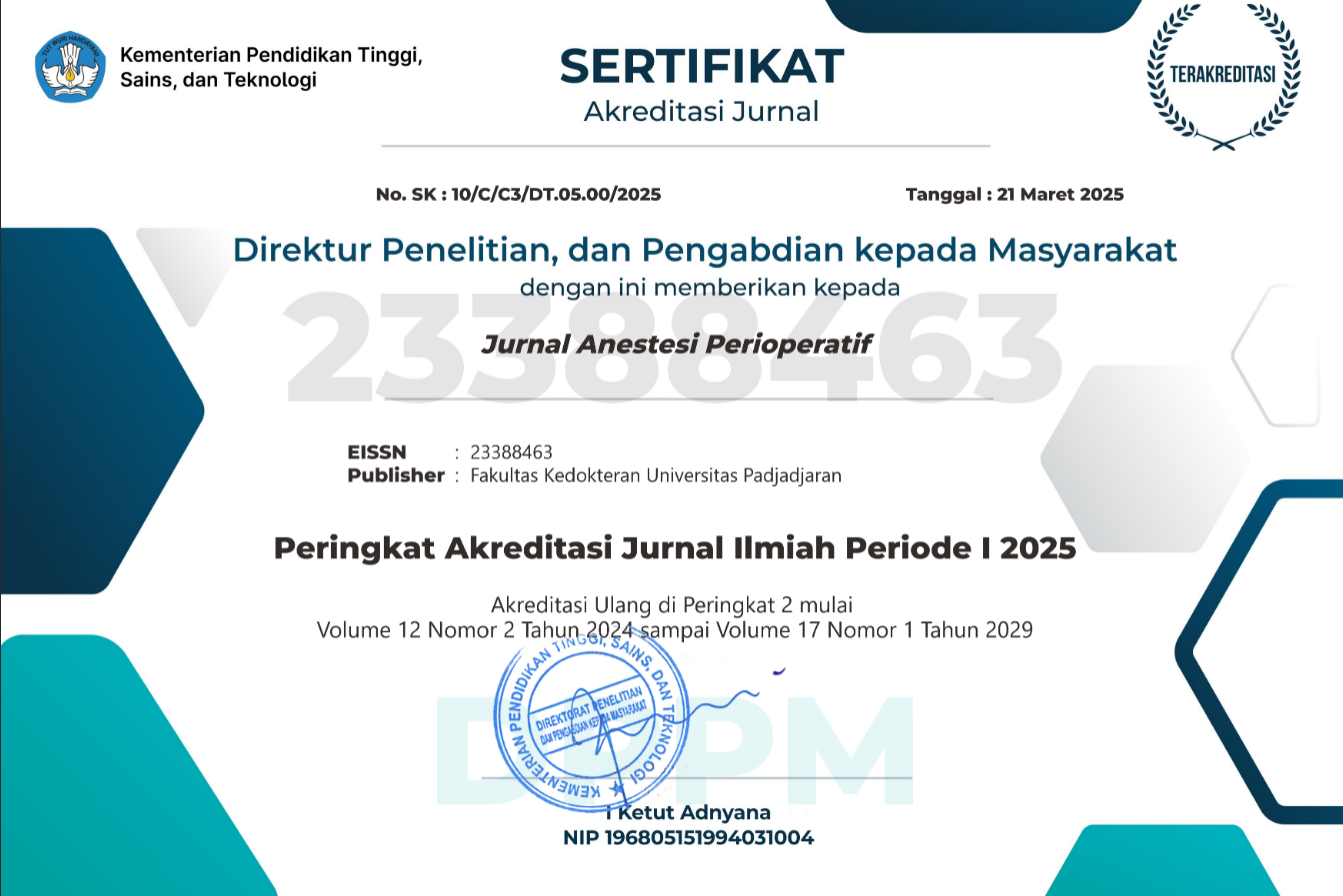Hubungan Protein Carbonyl dengan Kejadian Kematian 28 Hari Pasien Sepsis di Ruang Rawat Intensif dan Resusitasi
Abstract
Kondisi sepsis yang memburuk dapat mengarah ke disfungsi multiorgan, syok, dan berujung pada kematian. Beberapa marker yang menandai kerusakan organ pada sepsis diantaranya penurunan kadar glutathione, peningkatan kadar malondialdyhide serum, dan protein carbonyl (PCO). Namun, konsentrasi PCO lebih dikaitkan dengan mortalitas pasien dengan syok sepsis yang dirawat di ruang rawat intensif dan resusitasi. PCO terbentuk lebih awal dan stabil dibandingkan produk peroksidasi lipid. Tujuan penelitian ini untuk mengetahui hubungan kadar PCO dengan kematian pasien sepsis. Penelitian ini merupakan kohort retrospektif. Data penelitian merupakan data sekunder dari rekam medis Rumah Sakit Mohammad Hoesin (RSMH). Sampel penelitian adalah seluruh rekam medik pasien terdiagnosis sepsis dan dirawat di ruang kritikal RSMH Palembang selama periode Februari–Agustus 2019, yang memenuhi kriteria inklusi dan eksklusi. Hasil penelitian dianalisa dengan uji chi-square, Fisher’s Exact Test. Didapatkan 59 subjek penelitian yang memenuhi kriteria penelitian mayoritas berjenis kelamin laki-laki (50,8%), dirawat di ruang Resusitasi (57,6%), diagnosis medikal (62,7%), dan meninggal (67,8). Dari uji analisis ROC didapatkan bahwa cut-off point PCO terletak pada nilai >20,33 dengan sensitivitas sebesar 72,50% dan spesifisitas 84,21% dengan nilai Area Under Curve sebesar 0,735 yang menunjukkan bahwa PCO memiliki kemampuan memprediksi mortalitas yang kuat. PCO memiliki hubungan dengan kejadian kematian pasien sepsis di RSMH Palembang dan dapat dijadikan suatu biomarker untuk memprediksi tingkat mortalitas pada pasien sepsis.
Correlation of Carbonyl Protein with the 28-Day Death Incidence of Sepsis Patients in the Intensive Care Unit and Resuscitation Room
Deteriorating sepsis can lead to multi-organ dysfunction, shock, and death. Some indictors that mark organ damage in sepsis include decreased glutathione levels, increased serum malondialdehyde levels, and Carbonyl protein (PCO). However, the concentration of carbonyl protein is more associated with the mortality of patients with septic shock treated in the intensive care unit and resuscitation room. PCO is formed earlier and more stable than lipid peroxidation products. The purpose of this study was to determine the relationship of PCO levels with the death of sepsis patients. This study was a retrospective cohort. Research data were secondary data from RSMH medical records. The study sample was all medical records of patients diagnosed with sepsis, which met the inclusion and exclusion criteria and treated in the critical room of Mohammad Hoesin Hospital Palembang (RSMH) from February toAugust 2019. The data analysis used the chi-square test, Fisher’s Exact Test. A total of 59 research subjects met the research criteria the majority subjects were male (50.8%), treated in the resuscitation room (57.6%),diagnosed medically (62.7%), and died (67.8). From the ROC analysis test, it was found that the PCO cut-off point was at a value >20.33 with a sensitivity of 72.50% and a specificity of 84.21% with an area under curve value of 0.735, which showed that the PCO had a strong ability to predict mortality. PCO has a relationship with the incidence of mortality of sepsis patients in RSMH and can be used as a biomarker to predict the mortality rates in sepsis patients.
Keywords
Full Text:
PDFReferences
Singer M, Deutschman CS, Seymour CW. The third international consensus definitions for sepsis and septic shock (Sepsis-3). JAMA. 2016;315(8):801−10.
Stevenson EK, Rubenstein AR, Radin GT, Wiener RS, Walkey AJ. Two decades of mortality trends among patients with severe sepsis: a comparative meta-Analysis. Crit Care Med. 2014; 42(3):625–31.
Wang YG, Zhou JC, Wu KS. High 28-day mortality in critically ill patients with sepsis and concomitant active cancer. J Int Med Res. 2018;46(12):5030–9.
Singer M. The role of mitochondrial dysfunction in sepsis-induced multi organ failure. Landes Bioscience. 2014;5(1):66–72
Costa. Protein carbonyl, but not malondialdehyde, is associated with icu mortality in patients with septic shock. J Intens Care Med. 2017;20(10):1–5.
Lorente L Mart ́ın MM, Abreu-Gonza ́lez P, Dominguez-Rodriguez A, Labarta L, Diaz C, et al. Prognostic value of malondialdehyde serum levels in severe sepsis: a multicenter study. PLoS One. 2013;8(1):1–5.
Weiss SL, Deutschman CS. Elevated malondialdehyde levels in sepsis-something to stress about? Crit Care. 2014;18(2):125.
Costa NA, Gut AL, Azevedo PS, Tanni SE, Cunha NB, Fernandes AAH, dkk. Protein carbonyl concentration as a biomarker for development and mortality in sepsis-induced acute kidney injury. Biosci Rep. 2018;38(1):1–20.
Bone RC, Balk RA, Cerra FB, Dellinger P, Fein AM, Knaus WA, et al. Definitions for sepsis and organ failure and guidelines for the use of innovative therapies in sepsis. Chest Journal. 1992;101(6):1644–55.
Nachtigall I, Tafelski S, Rothbart A, Kaufner L, Schmidt M, Kartachov M, dkk. Gender-related outcome difference is related to course of sepsis on mixed ICUs: a prospective, observational clinical study. Crit Care. 2011;15(3): 151.
Nasir N, Jamil B, Siddiqui S, Talat N, Khan F, Hussain R. Mortality in sepsis and its relationship with gender. Pak J Med Sci.2015;31(5):1201–6.
Pietropaoli A, Glance LG, Oakes D, Fisher SG. Gender differences in mortality in patients with severe sepsis or septic shock. Gend Med. 2010;7(5):422–37.
Villar J, Short JH, Lighthall G. Lactate predicts both short-and long-term mortality in patients with and without sepsis. Infect Dis (Auckl). 2019;12:1178633719862776
DOI: https://doi.org/10.15851/jap.v8n1.1993
Article Metrics
Abstract view : 751 timesPDF - 374 times
This Journal indexed by

JAP is licensed under a Creative Commons Attribution-NonCommercial 4.0 International License
View My Stats



